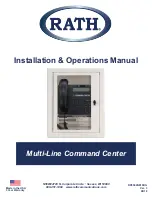
Operational, Basic, and Advanced Parameters
41-001343-02 REV05 – 07.2014
A-27
Local SIP TLS Port
SIP STUN Parameters
Parameter
–
sip local tls port
Configuration Files
aastra.cfg, <model>.cfg, <mac>.cfg
Description
Specifies the local source port (SIPS/TLS) from which the phone sends SIP messages.
Format
Numeric
Default Value
5061
Range
Greater than 1024 and less than 65535
Notes:
•
It is recommended that you avoid the conflict with any TCP ports being used. For
example: WebUI HTTP server on 80/tcp and HTTPS on 443/tcp.
•
By default, the IP phones use symmetric TLS signaling for outgoing TLS SIP messages.
When symmetric TLS is enabled, the IP phone uses port 5061 as the persistent TLS
connection source port. When symmetric TLS signaling is disabled, the IP phone
chooses a random persistent TLS connection source port from the TCP range (i.e.
49152...65535) for TLS messages after each reboot regardless of whether the param-
eter “sip outbound support” is enabled or disabled.
Example
sip local tls port: 5061
Parameter
–
sip stun ip
Configuration Files
aastra.cfg, <model>.cfg, <mac>.cfg
Description
IP address and/or qualified domain name of the
STUN
server (also know as Simple
Traversal of UDP through NAT).
STUN
is a protocol that governs the exchange of data over a UDP connection by com-
munication devices operating behind a NAT or firewall. Since the behaviors of NATs can
be different, the STUN protocol allows the exchange of data to be consistent over any
type of NAT.
The STUN/TURN configuration is only used for media (RTP traffic) that goes through
the server - not for signaling. (For signaling, you need to enable Rport if the NAT device
does not recognized SIP).
The STUN/TURN configuration applies globally to each phone.
If you configure both STUN and TURN on the phone, it discovers what type of NAT
device is between the phone and the public network. If the NAT device is full cone,
restricted cone, or port restricted cone, the phone uses STUN. If the NAT device is sym-
metric, the phone uses TURN. If you configure STUN only, the phone uses STUN with-
out the NAT discovery process.
Notes:
•
The NAT IP configuration parameter takes precedence over the STUN and TURN
parameters.
•
STUN does not work if the NAT device is symmetric.
Format
IP Address or Fully Qualified Domain Name (FQDN)
Default Value
0.0.0.0
Range
Two (2) IP addresses or domain names separated by a comma
Note:
The first is the primary and the second is the backup.
Example
sip stun ip: 10.50.103.12, stunbackup.aastra.com
















































